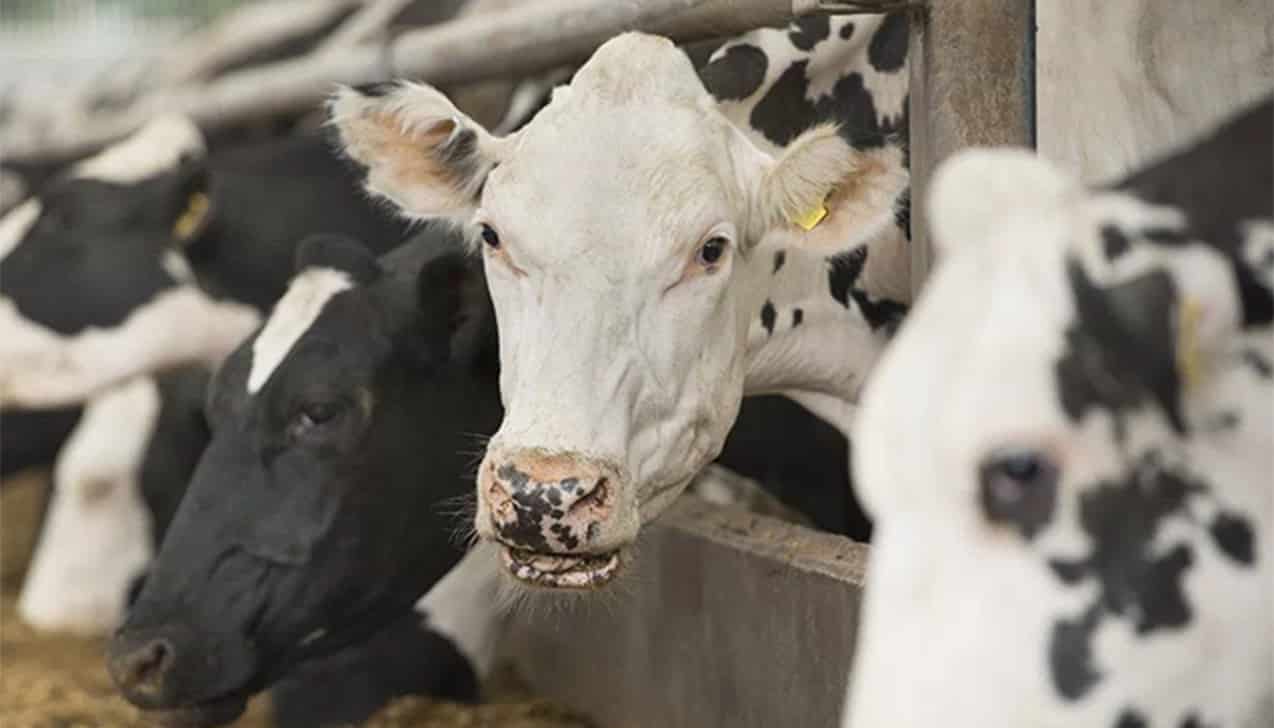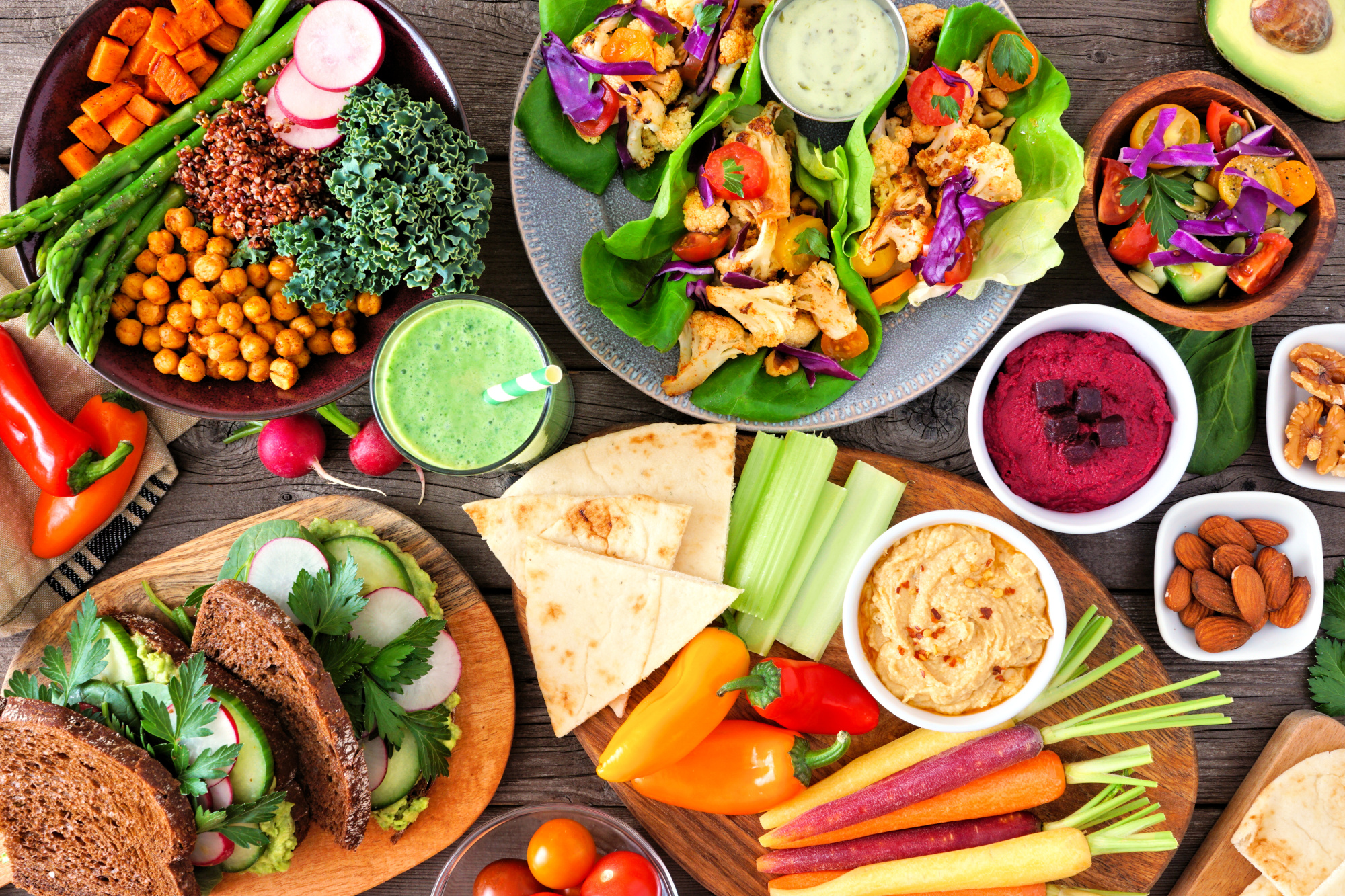Dairy products are among the most frequently consumed animal products worldwide. Due to the enormous volume of milk production, dairy cows, who are intelligent, empathetic, and affectionate animals, must endure uncomfortable and stressful conditions which do not meet even their most basic needs. ProVeg takes a look at dairy farms and draws attention to delicious alternatives to milk.
Cows and their basic needs
Left to their own devices, cows live in herds of around 20 individuals together with their young, establishing a clear hierarchy with an alpha cow.1 They spend most of their time grazing, covering several kilometers per day. Their other main pastime is rumination, during which they lie down and rest.
Cows are intelligent and emotional individuals
Cows are extremely inquisitive and intelligent animals. They have long-term memories and can learn from one another. Cows have distinct personalities and forge close, lifelong friendships. The bond between a mother cow and her calves is particularly strong. Like humans, they mourn the loss of friends and family members. Cows are affectionate mothers and share the responsibility of watching over their playful calves with other females in the herd.2
Cows in the dairy industry
On today’s industrial dairy farms, cows are bred specifically to maximise milk production. As a result of this breeding, the average milk yield per cow has risen dramatically over the years. Calves naturally require about eight litres of milk per day for healthy growth. In contrast, modern breeds of dairy cows on industrial farms produce up to 12,000 litres of milk per year, bout 20 litres per day on average. The lactation period of a cow (the time in which a cow produces milk) is about 305 days. Within the first 100 days 50% of milk and up to 50 liters per day are produced.3 4 As a result, while the number of cows on dairy farms in Europe has declined over the years, the volume of milk produced has increased.5 In order to produce a single litre of milk, a cow’s body must pump half a tonne of blood through her udder.
Living conditions and treatment of dairy cows
Worldwide, more than 265 million dairy cows produce more than 680 million tonnes of milk annually.6 Living conditions vary considerably, ranging from pasture grazing to intensive indoor confinement. In the EU, there is no specific legislation concerning the welfare of cattle.7
Pasture feeding
Contrary to popular belief and what industry advertisers would like people to believe, even pasture-fed dairy cows do not spend all their time in pastures. The exact grazing time in the EU is unknown.8 The available estimates indicate great variability on grass access; from 98% of cows in Ireland, that have access to grass on seasonal bases, to 10% in Greece and almost zero in Bulgarian dairy farms.9 The rest of the year, they usually live in either tie stalls or cubicles. Cows seen grazing outside are typically beef cattle or young dairy cows before their first calving.
Tie stalls
On many commercial dairy farms, cows live in cramped stalls, tied in place with a chain or rope. Many people never heard or read anything about tie stalls.10 These conditions are so restrictive that, for much of their lives, cows in tie stalls are unable to walk, turn around, groom, look to the side, or interact with other herd members in a natural way.
Cubicles
In another common farming system, dairy cows live in 3.4 to 4.0 m² cubicles, with functional areas for resting, walking, feeding, and milking. In most cases, cubicle floors consist of concrete slats, making it slippery and stressful for cows to move around.
Cow’s milk is mother’s milk
Like all mammals, cows produce milk only after giving birth. In order to maintain milk production levels, industrial dairy cows are forcibly inseminated each year. Like humans, cows gestate for nine months. During this time, cows are milked up until just two months prior to calving.11 12
Newborn calves are separated from their mothers within a few hours of birth since the mother’s milk is reserved for human consumption. The separation is traumatic for both the mother and her calf. For constantly giving milk, dairy cows have to calve once a year which means that they will be inseminated again six to eight weeks after giving birth.13
Dehorning of dairy cows
Like their bull brothers, cows grow horns. Horns are used to communicate between herd members and resolve conflicts.14 However, most modern farms dehorn calves to save space and reduce the risk of cows injuring each other due to the stress of their living conditions. Dehorning is a painful procedure in which the nerve endings and blood vessels from which the horns grow are burned off, usually without anaesthetic.
Calves as a ‘byproduct’ of the dairy industry
Most female calves born to dairy cows face the same fate as their mothers. They are isolated in small pens for the first eight weeks of their life, then spend the remainder of their lives producing milk for the dairy industry.
Male calves and ‘surplus’ females are most commonly sold to fattening farms, where they spend a few weeks gaining weight until they are slaughtered and sold as veal. In 2018 around 640,000 tonnes of veal were produced in the European Union, a significant proportion of which came from dairy cattle breeds.15
In total, more than 300 million cows are slaughtered for beef around the world each year.16 Beef production in the Amazon rainforest is the biggest cause of deforestation,17 and well as a major contributor to global greenhouse gas emissions.18
Dairy cow slaughter
Around 7.2 million dairy cows are slaughtered annually in the European Union.19 Worldwide, commercial dairy cows are usually slaughtered as soon as their milk production starts to decline, generally between 4.5 and 6 years of age.20 Cows who fail to conceive after their first insemination, as well as those who do not produce sufficient levels of milk after their first calving, are slaughtered at even younger ages.
Immediately before slaughter, cows are knocked unconscious with a stunbolt gun. However, a significant number of cows are improperly stunned and left to bleed to death while partly or fully conscious.21 In Germany, for example, that number varies from 5% to 9% of individuals slaughtered.22
Between 10% and 20% of cows are pregnant when they are slaughtered.23 24 25 26 Because the stunning bolt affects only the mother cows, in many cases the unborn calves are conscious during the ordeal. Afterwards, they are killed by the workers.
Health risks of dairy consumption
Dairy products are among the most consumed animal products around the globe, with more than 110 kg per person consumed each year, most of it in European countries or North America.27 Nevertheless, from a health perspective, there are various reasons why people prefer plant milk over cow’s milk. Most humans, like other mammals, gradually lose the intestinal enzyme lactase after infancy and, with it, the ability to digest lactose, which is the main form of sugar in milk. As much as 75% of the world’s adult human population is intolerant to ingested dietary lactose.28
Symptoms of lactose intolerance may include bloating, diarrhoea, gas, nausea, and pain in the abdomen.29 Another reason is cow’s milk allergy (CMA). CMA is the most common form of food allergy in infants and children, and is the result of an immunological reaction to certain proteins in cow’s milk, particularly β-lactoglobulin and casein, which can cause immediate hypersensitivity reactions.30 31 Chemical contaminants in milk and dairy products, such as antibiotics, hormones, and pesticides, also play a role in consumer choices.
Milk alternatives are growing in popularity
More and more consumers are questioning the consumption of cow’s milk and the effects that our diets have on animals, the environment, and our health. This is also reflected in the increasing demand for non-dairy milk. Plant milks have been consumed for centuries in various cultures, but their popularity has skyrocketed over the past decade. People choose plant milks over dairy milk for a variety of reasons. Whether it is for their nutritional value, animal welfare reasons, lower environmental impact, to avoid lactose or dairy milk allergens, or simply out of preference, there are many delicious options to try.
Read the ProVeg Plant Milk Report to learn more about non-dairy milk alternatives.
ProVeg supports the availability of plant-based milk alternatives
ProVeg does not only point out healthy, cruelty-free alternatives but also makes them more readily available. ProVeg supports and facilitates a range of vegan events throughout the year, from annual happenings such as VeggieWorld and VegMed to important one-off events such as CEVA trainings and legal and political symposiums. Furthermore, ProVeg advises and supports innovative companies that want to enrich the veggie market with their products. This ranges from mentoring early-stage start-ups to consulting for major international supermarket brands and administering the V-Label, which guarantees that a product is either vegan or vegetarian. Find out more about what we do to help the world transition to a more plant-based society and economy that are sustainable for humans, animals, and our planet.
References
- Sowell, B. F., J. C. Mosley & J. G. P. Bowman (2000). Social Behavior of Grazing Beef Cattle: Implications for Management. Journal of Animal Science 77
- Kent, J. P. (2020): The cow–calf relationship: from maternal responsiveness to the maternal bond and the possibilities for fostering. Journal of Dairy Research. 87, Cambridge University Press p.101–107
- Food and Agriculture Organization of the United Nations (2017). FAOSTAT Statistics Database. Available at http://www.fao.org/faostat/en/#data/QL [02.01.2017]
- Isermeyer, T., T. Hemme & J. Holzner (2003): Analysis of international competitiveness of milk production in the Framework of the IFCN. AGRIC. ECON. – CZECH, 49, 2003 (2): 94–100
- Food and Agriculture Organization of the United Nations (2017): FAOSTAT Statistics Database. Available at http://www.fao.org/faostat/en/#data/QL [02.01.2017]
- Food and Agriculture Organization of the United Nations (2017): FAOSTAT Statistics Database. Livestock Primary (2018) Available at http://www.fao.org/faostat/en/#data/QL [24.11.2020]
- European Commission. Cattle. Food Safety – European Commission. Available at https://ec.europa.eu/food/animals/welfare/practice/farm/cattle_en. [Accessed: 15.4.2020]
- Directorate-General for Health and Food Safety (European Commission) (2017): Overview report. Welfare of Cattle on Dairy Farms.
- ‘The future of grazing’, European Grassland Federation, Wageningen UR Livestock Research Report 906, September 2014.
- Robbins, J. A., C. Roberts, D. M. Weary, et al. (2019): Factors influencing public support for dairy tie stall housing in the U.S. PLOS ONE. 14, Public Library of Science p.e0216544
- College of Agriculture, Food and Environment. Dry Period- An Important Phase for a Dairy cow. Available at: https://afs.ca.uky.edu/content/dairy-dry-period-an-important-phase-for-a-dairy-cow#:~:text=Length%20of%20dry%20period%3A%20Dry,less%20milk%20the%20next%20lactation. [03.12.2020]
- Holstein Foundation (2017): Milking and Lactation. Available at: http://www.holsteinfoundation.org/pdf_doc/workbooks/Milking_Lactation_Workbook.pdf [03.12.2020]
- Institute of Nebraska-Lincoln:Pregnant cows, timing of pregnancy, open cows, pregnancy rate. Available at: https://beef.unl.edu/faq/pregnant-cows [09.12.2020]
- Knierim, U., N. Irrgang & B. A. Roth (2015): To be or not to be horned—Consequences in cattle. Livestock Science 179 29–37. doi:10.1016/j.livsci.2015.05.014
- Eurostat (202017): Slaughtering in slaughterhouses – annual data. Meat Product = Calves. Available at http://appsso.eurostat.ec.europa.eu/nui/submitViewTableAction.do
- Food and Agriculture Organization of the United Nations (2017): FAOSTAT Statistics Database. Available at http://www.fao.org/faostat/en/#data/QL [07.03.2018]
- Henders, S., U. M. Persson & T. Kastner (2015): Trading forests: land-use change and carbon emissions embodied in production and exports of forest-risk commodities. Environmental Research Letters 10(12), 125012. doi:10.1088/1748-9326/10/12/125012
- Gerber, P., H. Steinfeld, B. Henderson, et al. (2013): Tackling climate change through livestock: a global assessment of emissions and mitigation opportunities. FAO, Rome
- Eurostat (2020): Slaughtering in slaughterhouses – annual data. Meat Product = Cows. Available at http://ec.europa.eu/eurostat/de/data/database [24.11.2020]
- DeLaval (2013): Cow longevity conference. Conference Proceedings. Available at: http://www.milkproduction.com/Global/PDFs/Cow%20Longevity%20Conference%20Proceedings%20.pdf [19.03.2018]
- EFSA Panel on Animal Health and Welfare (AHAW), S. S. Nielsen, J. Alvarez, et al. (2020): Welfare of cattle at slaughter. EFSA Journal 18(11), doi:10.2903/j.efsa.2020.6275
- Burger, K. (2015): Mit viel Liebe getötet. Süddeutsche Zeitung, 13.04.2015. Available at http://www.sueddeutsche.de/wissen/tierschlachtung-mit-viel-liebe-getoetet-1.2429399 [03.01.2017]
- Maurer, P., E. Lücker & K. Riehn (2016): Slaughter of Pregnant Cattle in German Abattoirs – Current Situation and Prevalence: A Cross-Sectional Study. BMC Veterinary Research 12, no. 1. doi:10.1186/s12917-016-0719-3.
- Di Nicolo K (2006): Studie zum zusätzlichen Eintrag von Hormonen in die menschliche Nahrungskette durch das Schlachten von trächtigen Rindern in der Europäischen Union am Beispiel von Luxemburg und Italien. Dissertation med. vet. Universität Leipzig, Veterinärmedizinische Fakultät; Institut für Lebensmittelhygiene
- Singleton, G. H. & H. Dobson (1995): A Survey of the Reasons for Culling Pregnant Cows. The Veterinary Record 136, no. 7 (February 18, 1995): 162–65.
- Nielsen, S. S., P. Sandøe, S. U. Kjølsted, et al. (2019): Slaughter of Pregnant Cattle in Denmark: Prevalence, Gestational Age, and Reasons. Animals 9(7), 392. doi:10.3390/ani9070392
- Food and Agriculture Organization of the United Nations (2017). FAOSTAT Statistics Database. Available at http://www.fao.org/faostat/en/#data/FBS [08.03.2018]
- Silanikove, N., G. Leitner & U. Merin (2015): The Interrelationships between Lactose Intolerance and the Modern Dairy Industry: Global Perspectives in Evolutional and Historical Backgrounds. Nutrients. 7, p.7312–7331
- The National Institute of Diabetes and Digestive and Kidney Diseases(202017): Lactose Intolerance. Available at https://www.niddk.nih.gov/health-information/digestive-diseases/lactose-intolerance [21.12.2020]
- Knopfler, M. (2016): How Compatible is Cow’s Milk with the Human Immune System? The Science Journal of the Lander College of Arts and Sciences. Vol. 9. No. 2. p. 182- 190
- Bahna, S. L. (2002): Cow’s milk allergy versus cow milk intolerance. Ann. Allergy Asthma Immunol. 89, p.56–60



